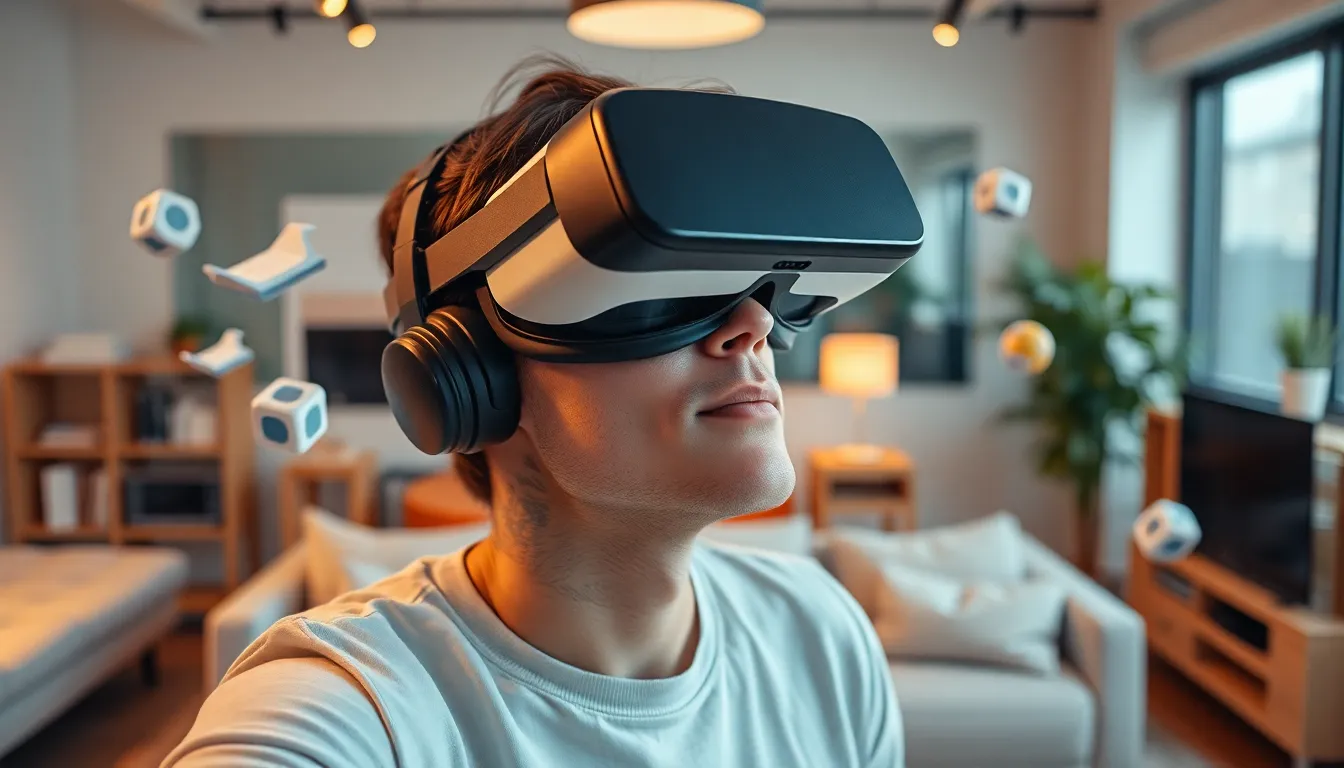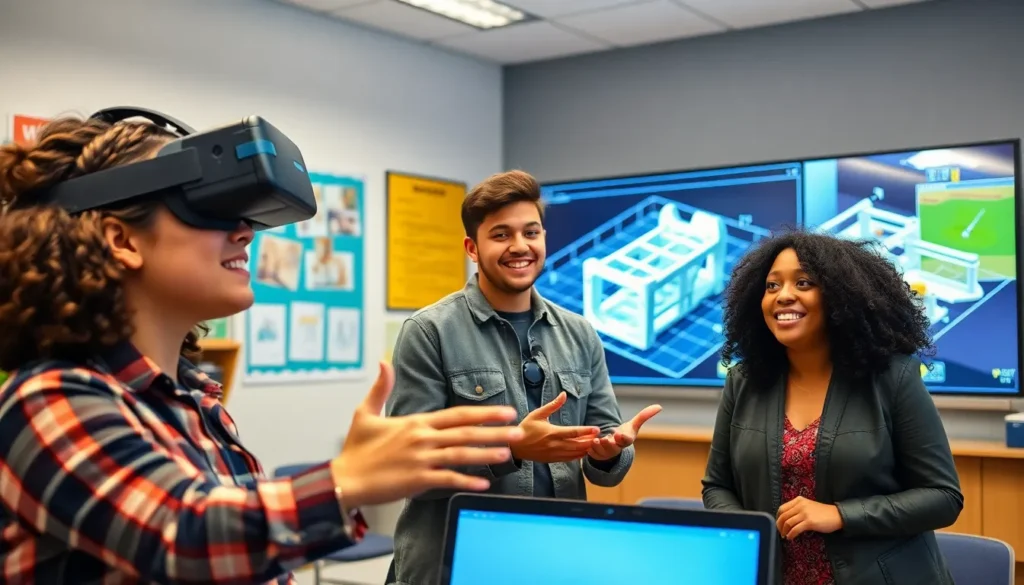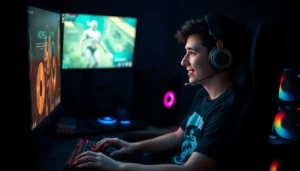Imagine blending the real world with digital wonders—it’s like having a superhero power without the spandex. Mixed reality applications are revolutionizing how people interact with their environment, merging the physical and virtual realms in ways that were once the stuff of sci-fi dreams. Whether it’s training surgeons or letting gamers battle dragons in their living rooms, mixed reality is here to shake things up.
Table of Contents
ToggleOverview of Mixed Reality Applications
Mixed reality applications integrate the physical and digital realms, creating unique interactive experiences. Businesses utilize these applications to enhance training exercises, allowing employees to practice skills in realistic scenarios. For instance, medical professionals engage in simulated surgeries to refine techniques without risking patient safety.
Education benefits significantly from mixed reality. Students explore complex subjects like biology through immersive 3D models. These models enable visual learning that traditional methods cannot provide. Likewise, architecture firms employ mixed reality to visualize projects during the design phase, improving client feedback.
Gaming experiences expand through mixed reality applications. Players interact with both physical elements and digital content. Popular titles like Pokémon GO exemplify this blend, encouraging players to explore real-world locations for virtual encounters.
Companies in manufacturing adopt mixed reality for assembly processes. Workers access real-time data overlays, increasing efficiency and reducing errors. This application streamlines workflows and boosts productivity, demonstrating the technology’s versatility.
Mixed reality also find use in retail. Shoppers use virtual try-ons to evaluate products before purchasing. This method enhances customer engagement, influencing buying decisions.
The entertainment industry incorporates mixed reality through immersive storytelling and interactive exhibits. Visitors experience narratives in ways that captivate attention and foster engagement. This innovation represents a shift in how audiences consume content.
Various sectors witness transformation due to mixed reality applications. The blend of physical and digital elements opens opportunities, enhancing interactions and optimizing processes across industries. Each application showcases the technology’s potential, establishing it as a crucial player in future advancements.
Key Technologies Powering Mixed Reality

Mixed reality applications rely on several key technologies to deliver immersive experiences. These technologies blend real and virtual environments seamlessly.
Augmented Reality
Augmented reality (AR) enhances the real world by overlaying digital information in real-time. For example, AR applications project text, images, or 3D models onto physical objects, allowing users to interact with their surroundings more dynamically. Popular tools like ARKit and ARCore facilitate this interaction, making AR accessible on mobile devices. Industries such as retail and education benefit significantly from AR, as it enhances visual aids, engages customers, and supports collaborative learning. By integrating contextual data, AR transforms mundane tasks into interactive experiences.
Virtual Reality
Virtual reality (VR) immerses users in a completely digital environment, blocking out the physical world. This technology creates a sense of presence, crucial for experiences in gaming, training, and therapy. Headsets like Oculus Quest and HTC Vive provide high levels of immersion that allow users to explore virtual spaces. Enterprises increasingly adopt VR for training simulations that replicate high-stakes environments, such as flight training or emergency response. Educational environments also leverage VR to transport students to historical sites or distant planets, enriching their learning experience through firsthand exploration.
Spatial Computing
Spatial computing integrates physical and digital spaces, enabling devices to understand their surroundings. Technologies such as LiDAR sensors, computer vision, and depth tracking help create interactive experiences vital for mixed reality applications. Spatial computing fuels navigation systems in sectors like logistics and robotics, improving efficiency and accuracy. This technology also enhances collaborative environments, allowing multiple users to interact with shared virtual content. By redefining how individuals interact with their surroundings, spatial computing forms the backbone of innovative mixed reality applications across diverse industries.
Industry Applications of Mixed Reality
Mixed reality applications significantly enhance various industries by integrating digital and physical elements, creating impactful experiences across sectors.
Healthcare
Healthcare professionals use mixed reality for surgical training and patient care. Surgeons benefit from realistic simulations, allowing them to practice complex procedures without risk. Mixed reality also assists in visualizing patient anatomy through 3D models, improving diagnoses and treatment plans. Medical students engage in immersive learning experiences that bridge theory and practice, enhancing their skills. For instance, companies like Osso VR provide realistic surgical simulations that make training more effective.
Education
In education, mixed reality transforms the learning environment. Students interact with 3D models and virtual scenarios, making complex subjects more graspable. By visualizing abstract concepts, learners enhance comprehension and retention. Schools adopt mixed reality tools to foster collaboration and creativity, allowing learners to explore historical events or scientific phenomena firsthand. For example, platforms such as zSpace let students dissect virtual organisms, providing an engaging learning experience.
Gaming and Entertainment
Gaming and entertainment industries thrive with mixed reality technologies. Players interact with both real-world environments and virtual elements, deepening immersion. Popular games like Pokémon GO exemplify how mixed reality blends gameplay with tangible surroundings, motivating players to explore their communities. Additionally, entertainment venues utilize mixed reality for interactive exhibits, offering audiences a unique and immersive storytelling approach, evident in attractions like The VOID.
Retail
Retailers harness mixed reality to boost customer engagement and streamline shopping experiences. Virtual try-on solutions allow shoppers to visualize products on themselves before purchasing, reducing return rates and enhancing satisfaction. Retail environments integrate mixed reality tools to create personalized recommendations, making shopping more interactive. Stores like IKEA use augmented reality applications to help customers visualize furniture in their homes, reinforcing the purchasing decision.
Benefits and Challenges of Mixed Reality
Mixed reality offers significant benefits alongside certain challenges in its application across various sectors.
Advantages
Enhanced engagement stands out as a primary benefit of mixed reality. Users experience immersive environments that blend real and digital elements. Improved learning outcomes result in educational settings, where students interact with 3D models, promoting better retention of knowledge. In healthcare, professionals utilize realistic simulations for training, leading to effective skill development. Retailers notice increased customer satisfaction, as virtual try-ons reduce uncertainties and boost purchasing confidence. Mixed reality also encourages collaboration among teams, facilitating innovative problem-solving in diverse fields.
Limitations
Mixed reality technology presents challenges that can hinder adoption. High costs associated with hardware and software remain significant hurdles, particularly for smaller businesses. Technical obstacles arise as users navigate complex setups and require robust internet connectivity for optimal performance. Privacy concerns also pose risks, with personal data usage from tracking technologies generating unease among consumers. Limited accessibility for individuals with disabilities restricts full integration into some environments. Moreover, ongoing development can lead to rapid changes, making consistent training a necessity for users.
Future Trends in Mixed Reality Applications
Mixed reality applications continue to evolve, shaping various sectors through innovative solutions. Emerging trends indicate enhanced integration of artificial intelligence with mixed reality, leading to smarter, more adaptive environments. Increased investment from tech giants emphasizes the growing importance of this technology.
Greater accessibility in mixed reality experiences stands out as a key trend. Developers focus on creating user-friendly interfaces and mobile solutions that reach a wider audience. This focus includes designing applications for individuals with disabilities, improving inclusivity in mixed reality.
In healthcare, predictive analytics is transforming patient care. Mixed reality applications may leverage data to provide personalized treatment plans, enhancing the overall patient journey. By utilizing real-time feedback, healthcare professionals can make informed decisions, improving outcomes.
The education sector is also witnessing advancements. Schools are adopting mixed reality tools to tailor learning experiences for diverse learning styles. By incorporating gamification, educators engage students more effectively, fostering motivation and retention.
Another notable trend is the rise of remote collaboration tools powered by mixed reality. Businesses emphasize the need for seamless communication in hybrid work environments. Virtual meeting spaces allow teams to collaborate on projects while visualizing data in real-time, enhancing productivity.
Emerging use cases in tourism and real estate showcase the versatility of mixed reality applications. Travelers can explore destinations through virtual tours, while prospective homebuyers visualize properties before visiting in person. These applications create immersive experiences that influence decision-making.
Finally, the entertainment industry is set to expand through interactive storytelling. Mixed reality short films and performances will create new formats for audience engagement. Unique experiences merge the physical and digital worlds, inviting viewers to participate actively in narratives.
Mixed reality applications are undeniably reshaping the landscape across multiple sectors. By blending the physical and digital realms, they enhance user experiences and drive innovation. The ongoing advancements in this technology promise to unlock even more potential, making interactions more immersive and effective.
As industries continue to explore these applications, the focus on accessibility and user-friendly designs will likely expand their reach. The integration of artificial intelligence and remote collaboration tools stands to further enhance the value of mixed reality.
With its growing presence in healthcare, education, retail, and entertainment, mixed reality is set to play a pivotal role in future developments. Embracing this technology will not only optimize processes but also redefine how individuals and organizations engage with the world around them.










